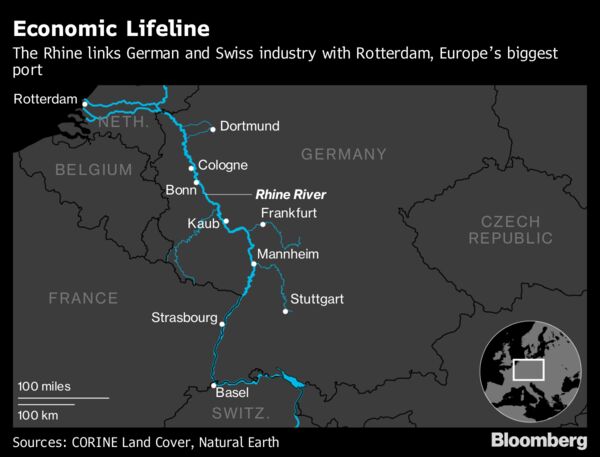William Wilkes and Brian Parkin
 Germany’s spring showers haven’t materialized this year, and that’s drying out the country’s most important river, prompting concerns that key industrial goods might have trouble making it to their destination.
Germany’s spring showers haven’t materialized this year, and that’s drying out the country’s most important river, prompting concerns that key industrial goods might have trouble making it to their destination.
Typically one of the wettest months, Europe’s biggest economy has received just 5% of its normal April rainfall so far, according to Germany’s federal weather service. It’s on course to be the driest month since records began in 1881.
In addition to yellowing vegetation that’s usually a lush green in this season, the dry spell has depressed water levels on the Rhine River, a conduit for barges delivering everything from steel to oil and coal to Germany’s factories. The river is now at its lowest level for the end of April since 2011.
“If we don’t get more normal rain in May, then we’re looking at another year of serious drought conditions,” said Andreas Friedrich of Germany’s DWD federal weather service.
With its source high in the Swiss Alps, the Rhine snakes more than 800 miles (1,300 kilometers) and carries cargo barges through some of Europe’s most important industrial zones before greeting the North Sea at Rotterdam. A mix of glacial run-off and rain feeds the river, but contribution from glaciers has dwindled in recent years as summer melting out paces ice formation in winter.
October 2018 saw rivers fall to just a few centimeters at a chokepoint near the village of Kaub, disrupting flows of fuels and goods to and from Germany’s advanced manufacturing heartlands in the south. The impasse was severe enough to dent German economic growth and underline how even advanced economies are feeling the impact of climate change.
Germany’s transport ministry last year announced plans aimed at ensuring the Rhine stays navigable for industrial ships even as waters continue to fall year by year. The scheme includes new early warning systems and dredging of some of the shallowest parts of the river.
Firms up and down the Rhine -- from Royal Dutch Shell Plc to BASF SE last year bought smaller boats, protectively booked truck and train capacity and crammed more supplies into warehouses, moved that could be repeated if Germany’s drought persists.
Waters at the Kaub bottleneck have fallen to 1 metre 15 centimetres, less than half the average water levels for this time of year. Officials at Switzerland’s federal weather service said heatwaves in summer 2019 -- where temperatures rose over 25 degrees Celsius in mountainous zones will further have destroyed glaciers, meaning they can’t be counted on to offset rain.
While scientists are confident that glacial shrinkage stems from global warming, they don’t yet link an intensifying rising trend of less rainfall in April to climate change, according to Germany’s federal weather service.
However, it is possible to suggest that the temperatures experienced across Europe this April have been enhanced due to global warming, and as warmer air can hold more moisture, that the evaporation rates have been increased, according to Simon Lee, climatologist at the University of Reading.
“We more commonly associate that effect with summertime heatwaves,” he said. “But the mechanism is the same, and as the growing season expands due to a warming climate, the impacts of these early-season warm spells may become more significant.”

No comments:
Post a Comment